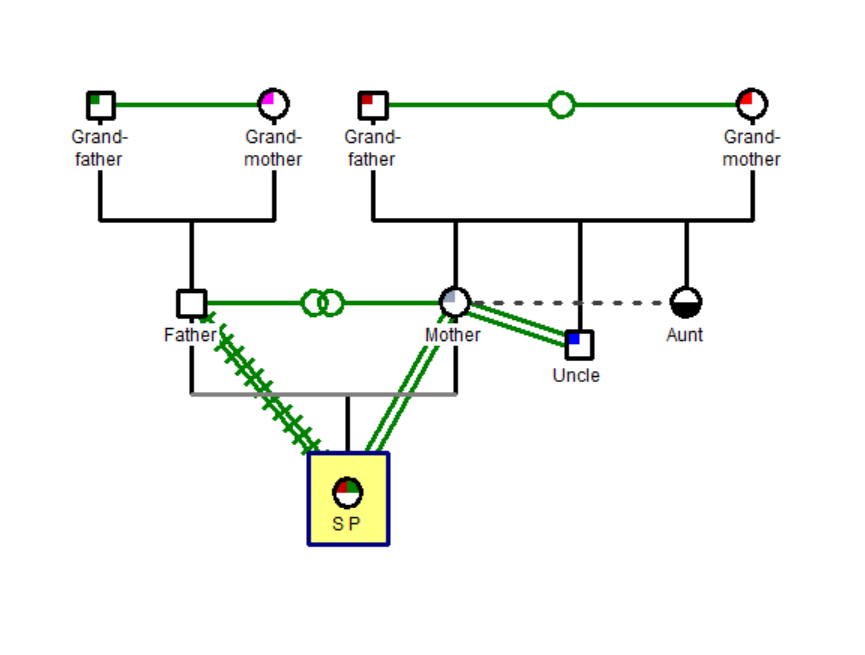The family consists of nine members. Emotional relations within the family are rather consistent and are mostly represented by love, respect, and compassion (Figure 1). Health history displayed on the genogram reveals several important facts.

SP’s grandfathers and grandmothers are all exposed to certain health problems. SP’s paternal line is represented by obesity in the grandfather and lung cancer in the grandmother. SP’s maternal line is represented by hypertension in the grandfather and heart illness in the grandmother. These factors all have a direct impact on SP and her health issues.
Genetics suggest that most probably SP would be exposed to some serious heart problems in the future (Parthiban, Skrivatsa, & Rajesh, 2011). As it can be seen in Figure 1, the relations between the grandfathers and grandmothers are harmonious, and there are no issues in terms of the emotional background. SP’s father is the only child in the family, and SP’ mother has a brother and a sister.
SP’s father does not have any health issues that would seriously affect his wellbeing or SP’s genetics. Nonetheless, it would be reasonable to perform a routine check-up in order to make sure that all of his vital signs are in the normal range. The emotional background between SP’s father and mother can be described as “in love” (Figure 1). The patient’s mother has arthritis. This may be a risk factor for SP, but additional tests should be performed in order to identify any probable connection. SP’s aunt suffers from alcohol addiction.
This does not have any indirect impact on the patient’s health, but it has a major influence on the emotional background within the family. SP’s mother has a weak connection with her sister because of her addiction. For the patient’s uncle things are even more serious as he suffers from depression. The latter is the result of his attempts to help his sister to get rid of the addiction and her rejection to accept his assistance. Regardless, SP’s mother is empathetic and maintains a friendship with her brother. The patient uncle’s depression is grave, and he should visit a doctor in order to receive proper treatment (Parthiban et al., 2011).
The current patient is the only child in the family. Her relationships with the parents can be described as friendship (best friends with father and friends with mother). SP suffers from a light form of obesity and hypertension. Mostly, heredity was the cause of these diseases. The nurse also accentuates the issues with SP’s nutritional pattern and passive lifestyle (Andersson & Walley, 2010). The patient’s hypertension is also accompanied by dyspnea. The nurse believes that immediate clinical measures should be taken in order to provide necessary care and minimize the risk of disease development.
SP’s hypertension might become a heart disease, and an uncontrollable diet would be the key reason for grave obesity (Andersson & Walley, 2010). Overall, the amalgamation of these factors can shorten the patient’s life of ten to fifteen years and lead to death. The nurse expects to provide knowledge for SP concerning her health issues and discuss the further possible events and actions (Parthiban et al., 2011). It would be reasonable to plan interventions intended to maintain and improve the patient’s health by mitigating and disposing of the risk factors of the combination of obesity and hypertension in SP.
References
Andersson, J. C., & Walley, A. J. (2010). The contribution of heredity to clinical obesity. Obesity Updates, 4(11), 25-52. Web.
Parthiban, G., Skrivatsa, A., & Rajesh, A. (2011). Diagnosis of heart disease for diabetic patients using naive Bayes method. International Journal of Computer Applications, 24(3), 7-11. Web.